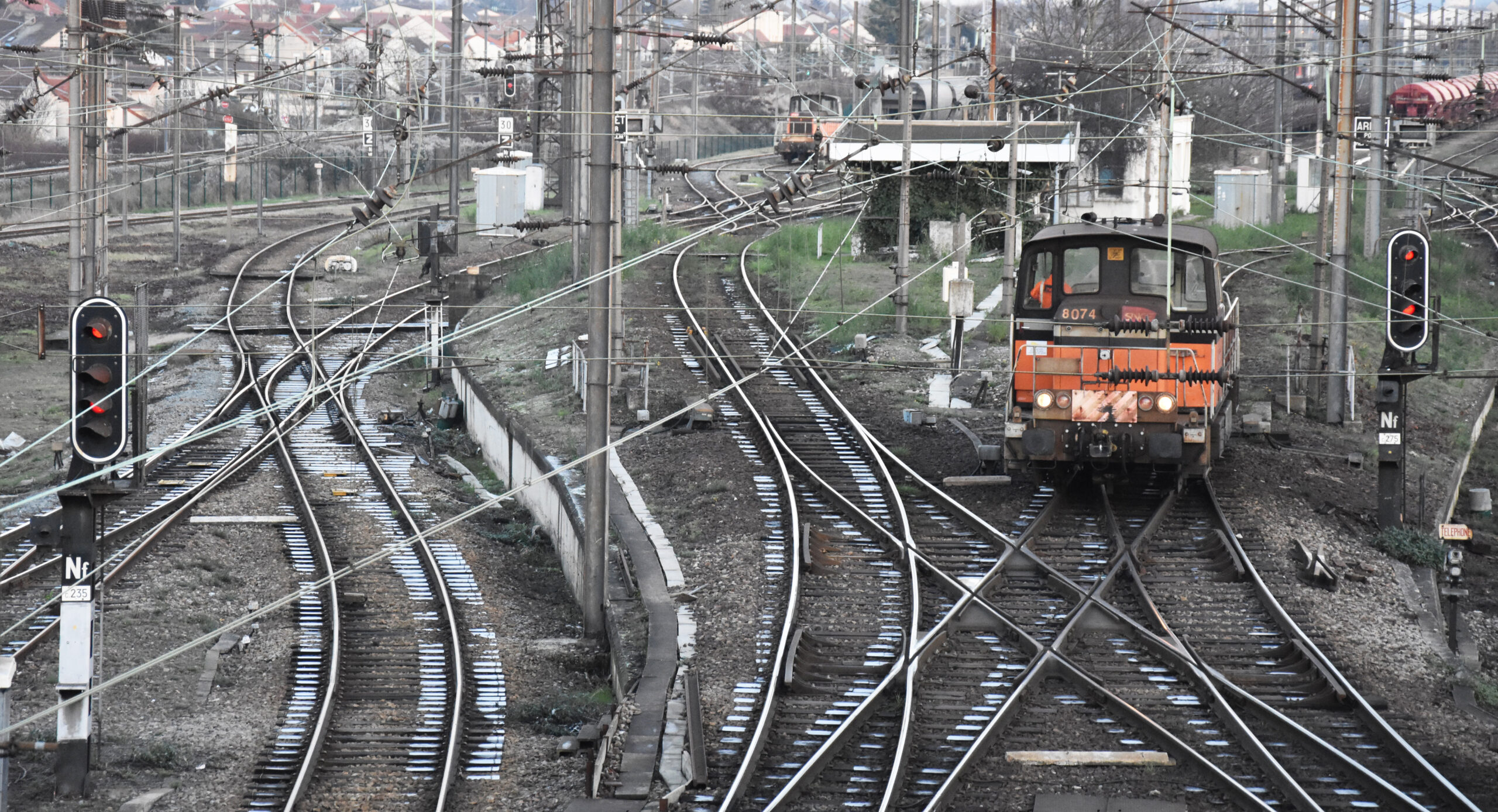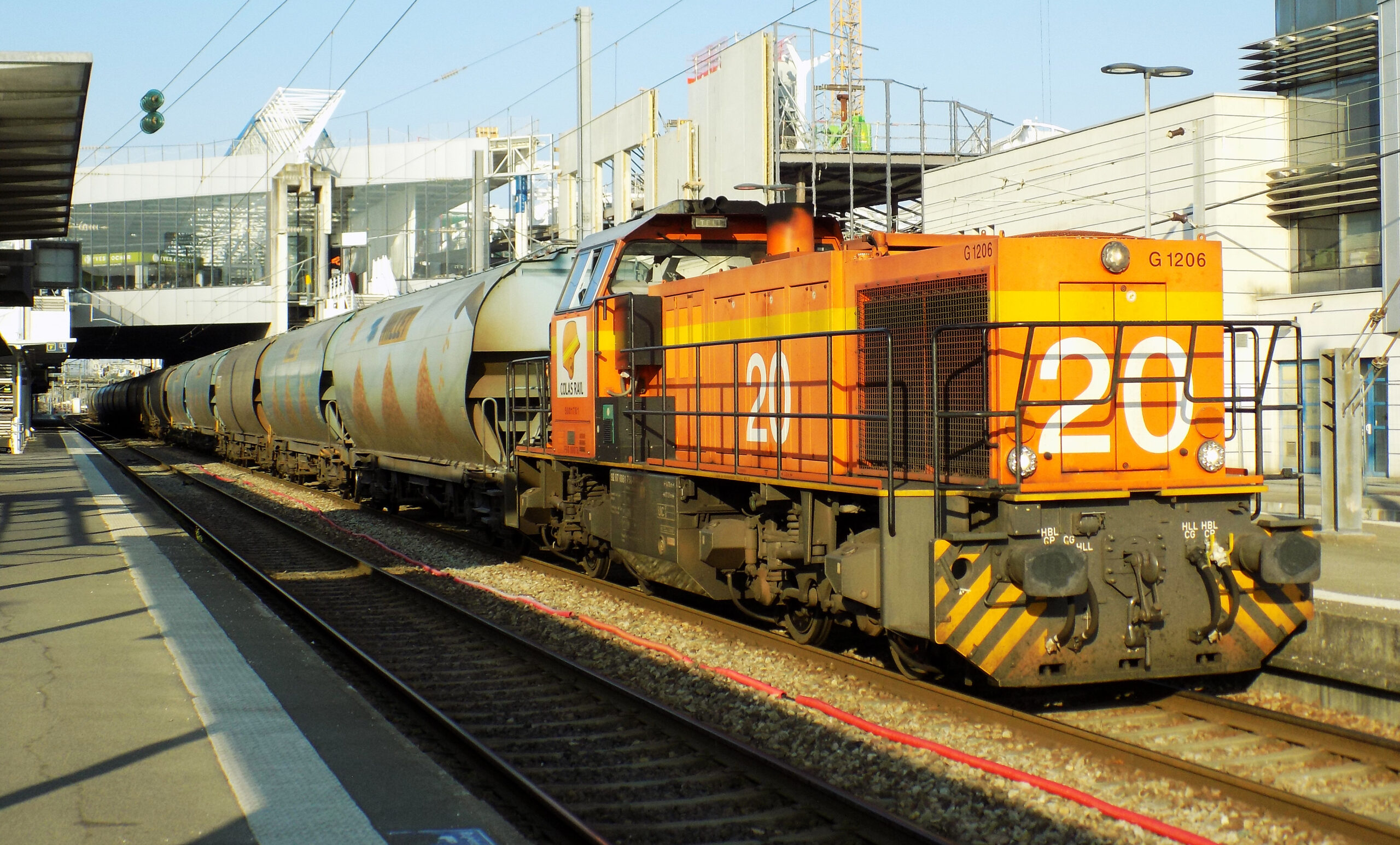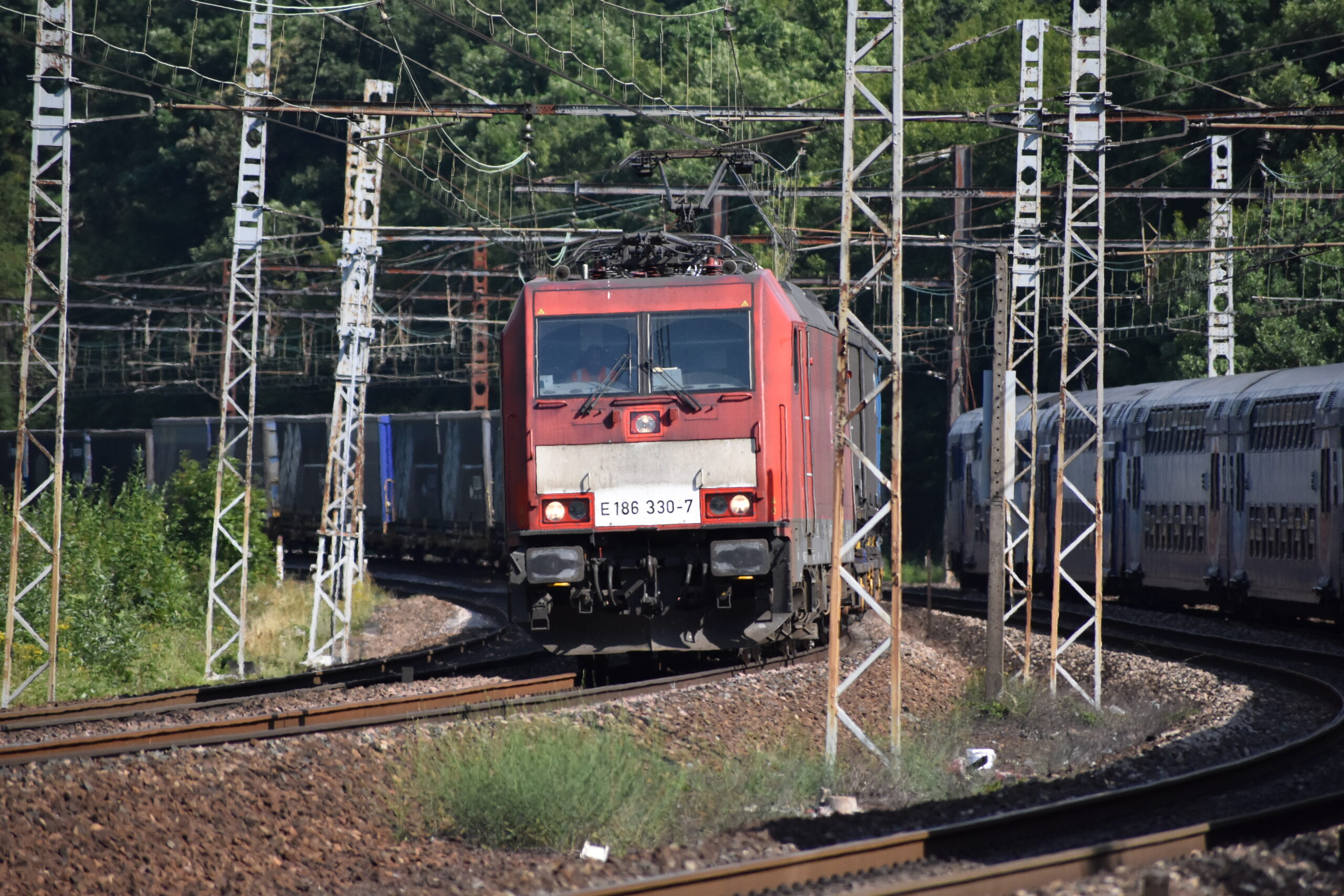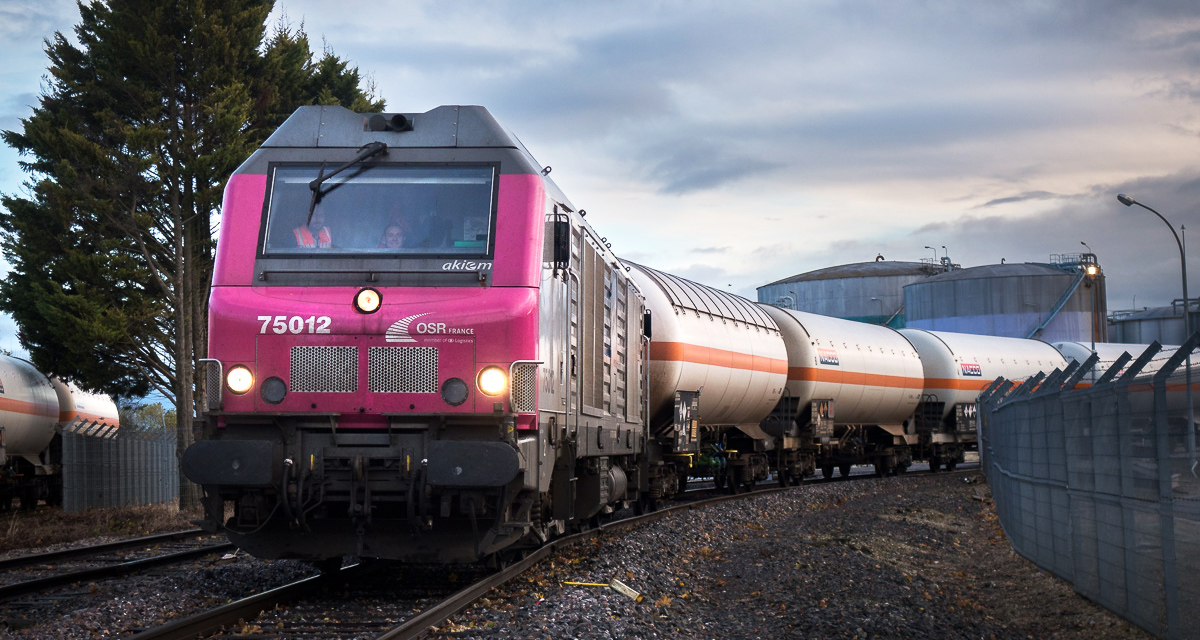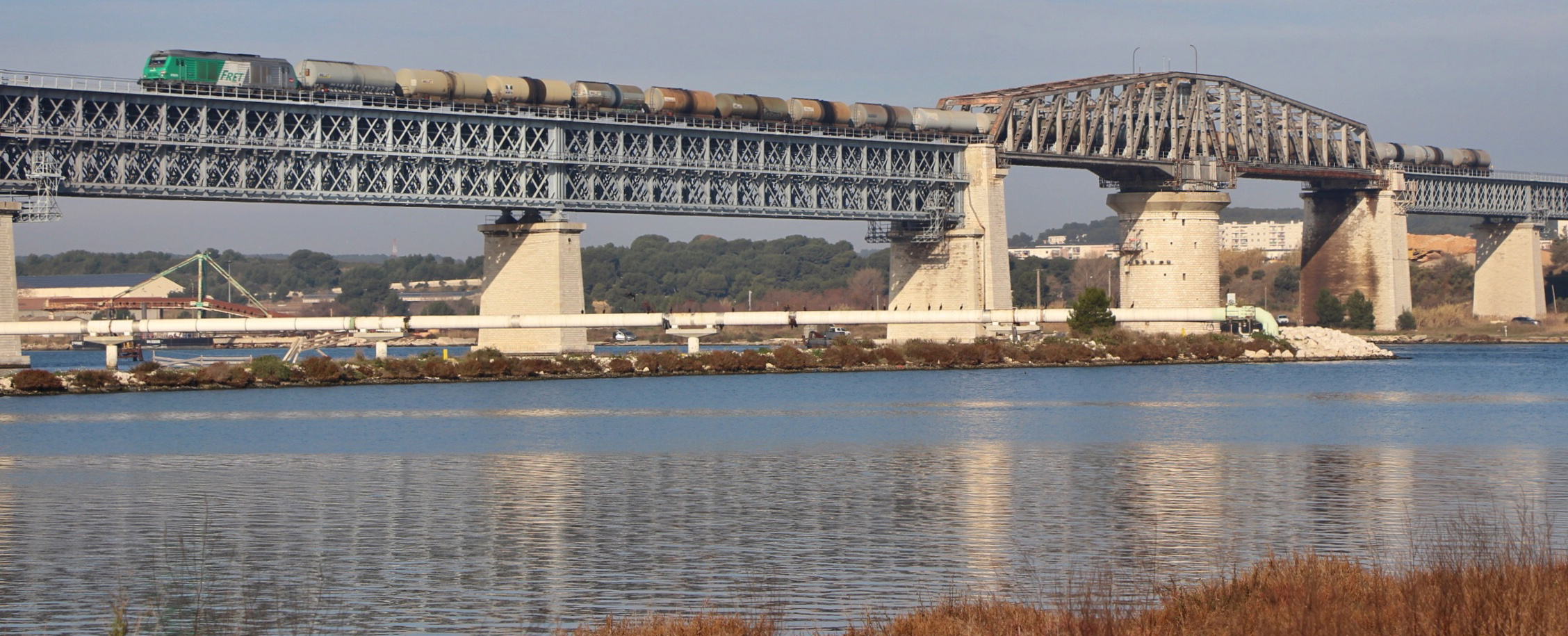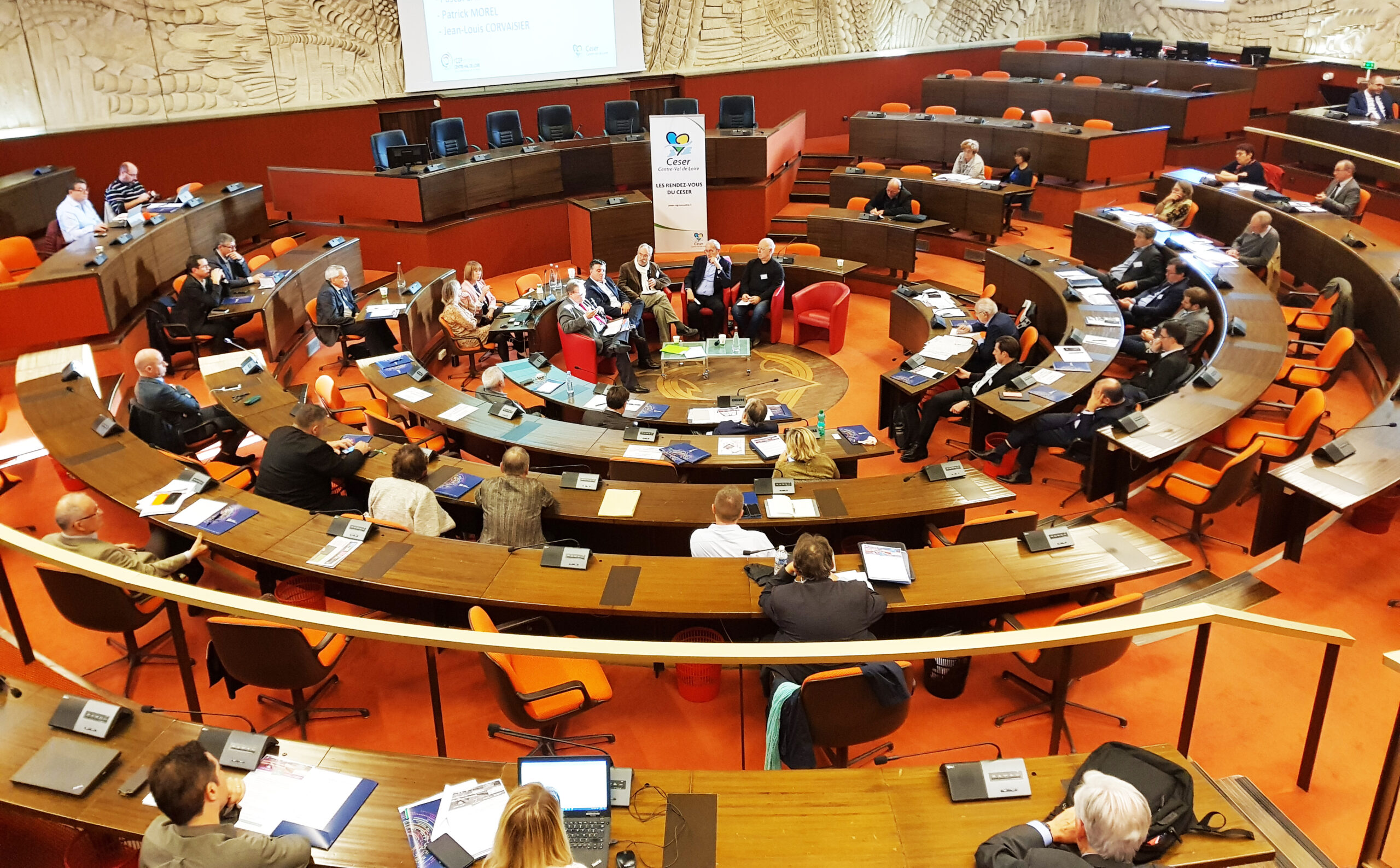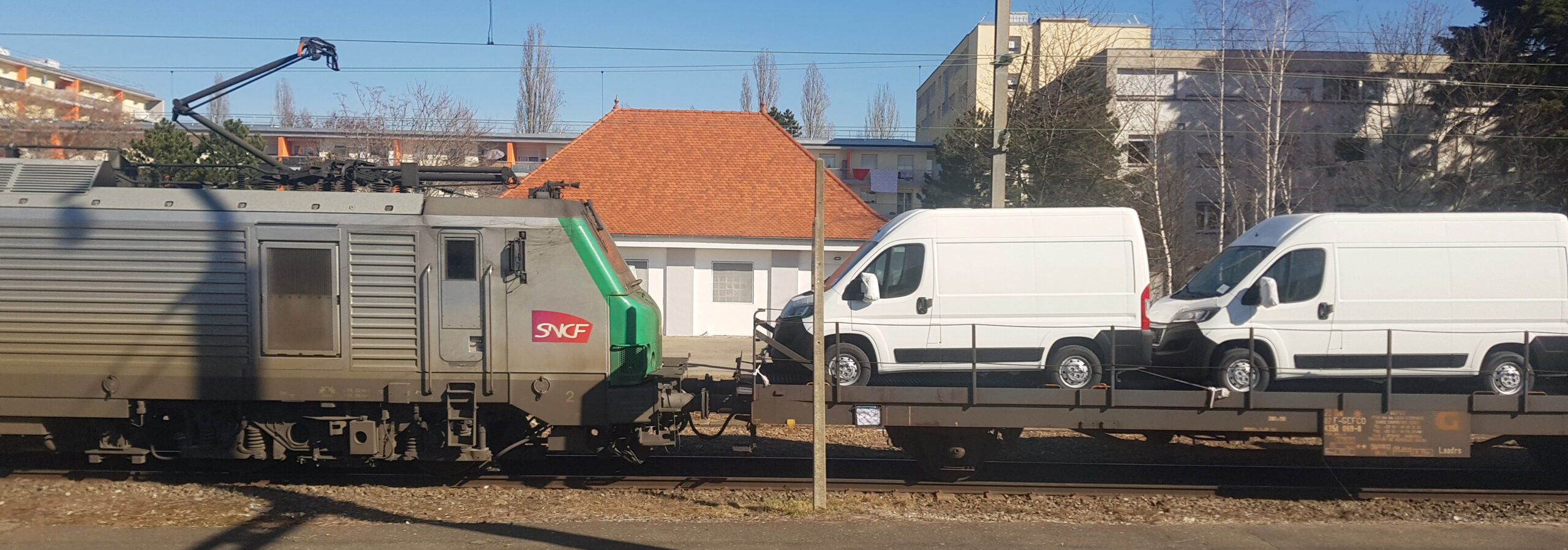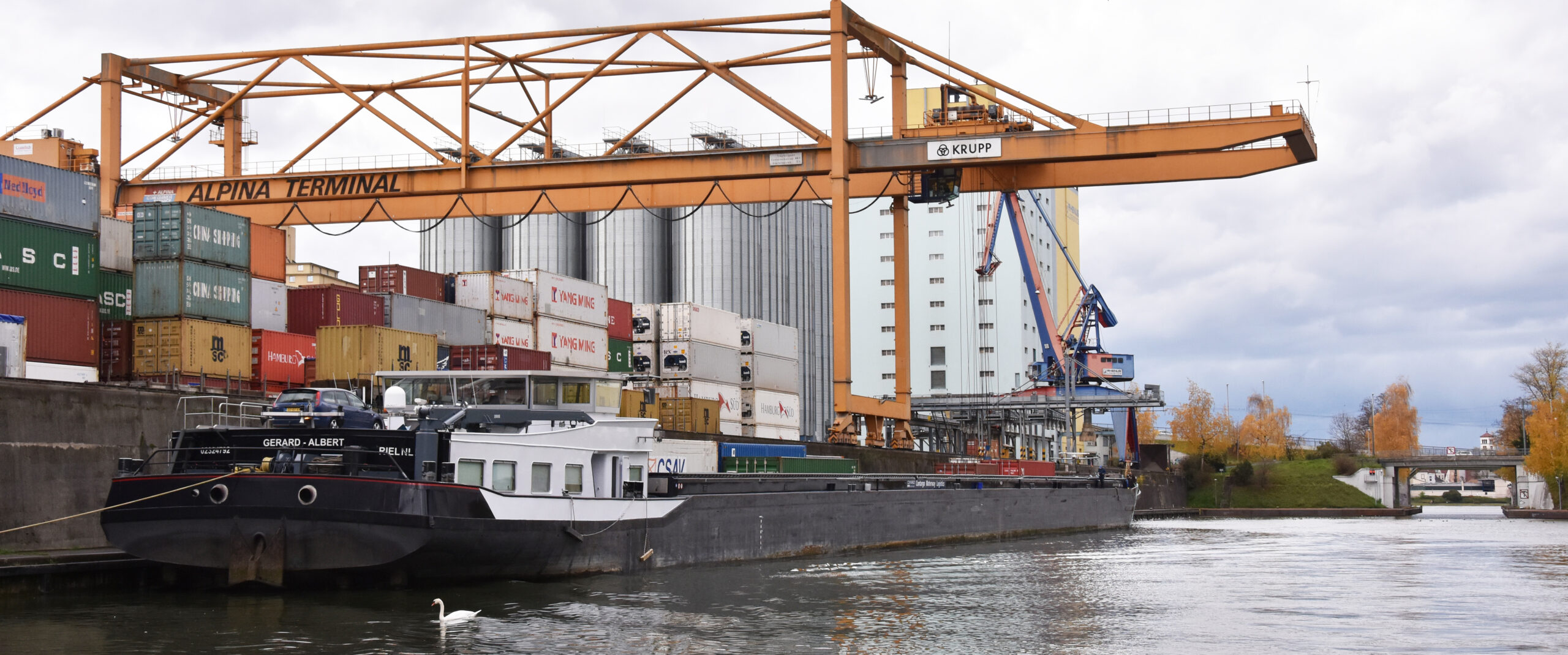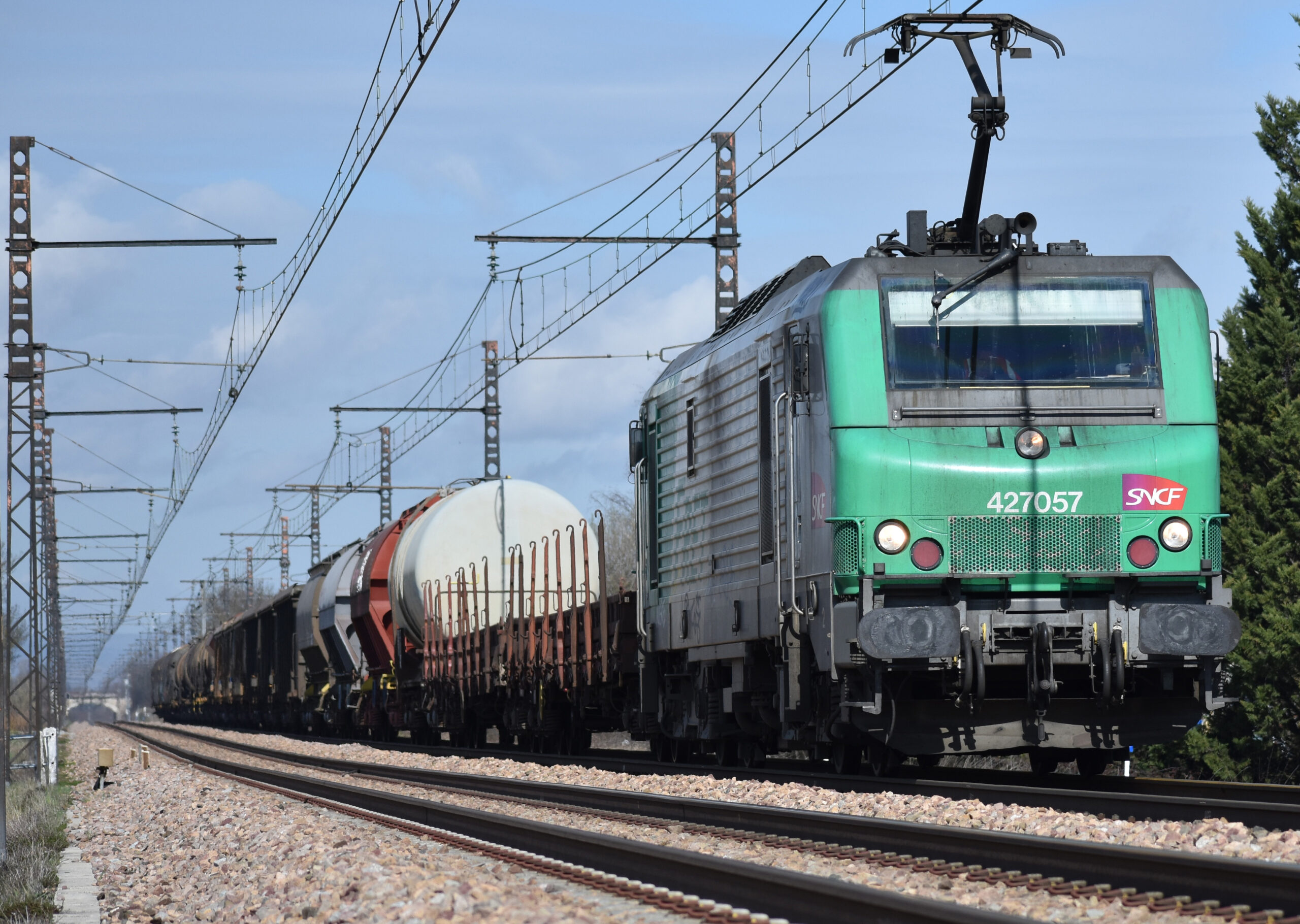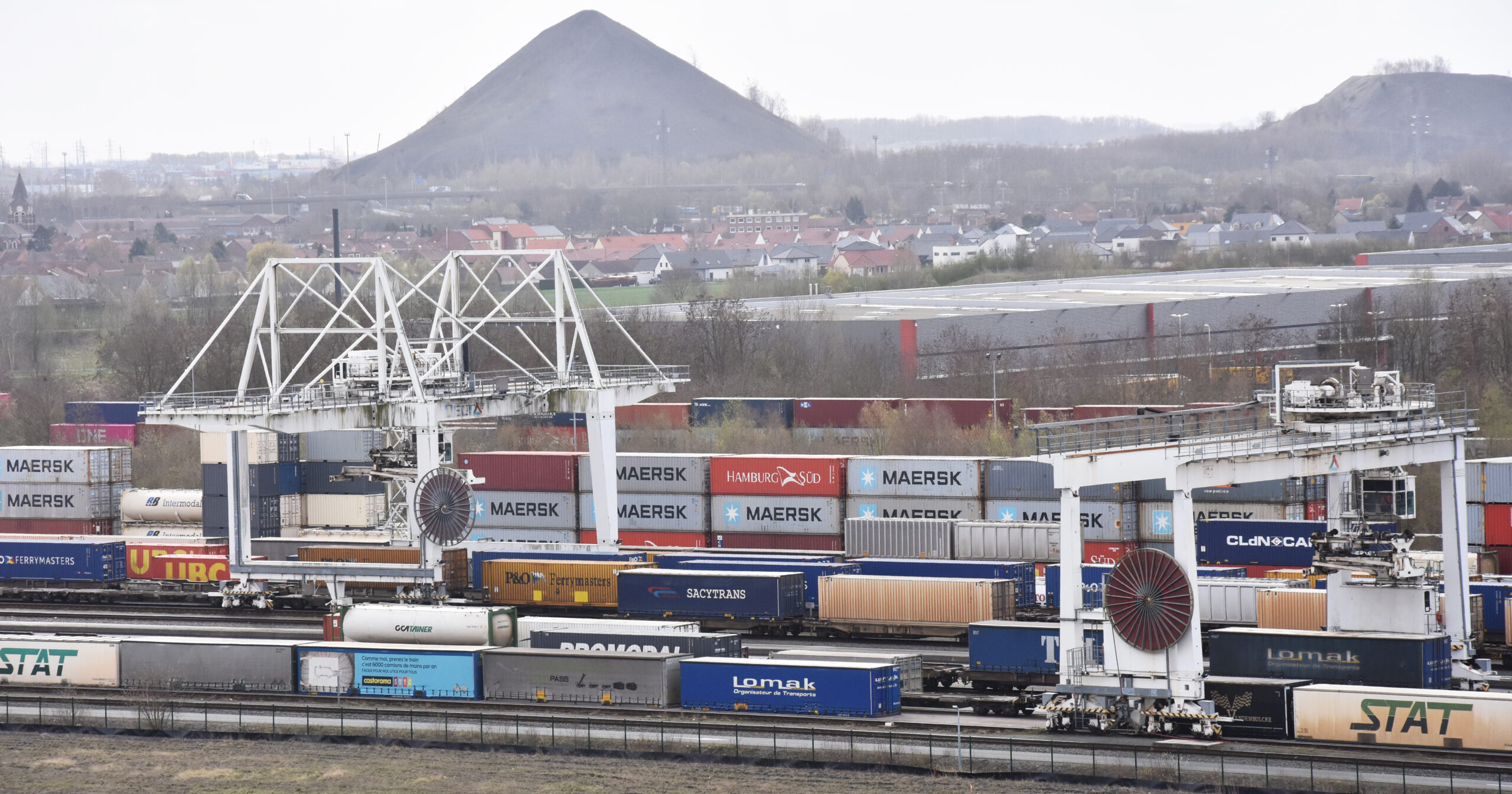Railweb Reports
French rail freight: act locally, but know the bigger picture
Posted by George Raymond on November 18, 2019
Rail freight conferences in October 2019 in Paris and Orléans illustrated a central issue in rail freight: ensuring that political and business units at regional, national, European and intercontinental level work together. The events spotlighted both international intermodal operators and one of metropolitan France’s 13 regions.
Le Bourget marshalling yard north of Paris, 13 December 2018. Photo © George Raymond
A conference organised by France’s national combined transport association GNTC on October 9 assembled actors of combined rail-road and barge-road transport in France, including trucking, barge and train-operating companies, combined transport operators, logistics platforms, ports and companies that make and lease equipment. The next day, a conference in Orléans, 75 minutes south of Paris by train, focused on efforts to re-launch rail freight in Centre-Val de Loire (CVL), one of 13 regions in metropolitan France.
Contents
| Goals, growth and Germany | |
| Pushing back the limits |
| Flexibility and costs | |
| Lobbying and cooperation | |
| Business development | |
| Ports and barges | |
| Specific services and markets | |
| Public policy |
Goals and growth of rail and combined transport
At the CVL event in Orléans, Pascal Sainson said his company, Europorte, has 5 to 7% of the French market, making it the largest of France’s small freight train operators. Mr Saison also works for the association AFRA, which promotes new train operators’ entry onto the French market. Rail freight’s market share in Europe is 15%; the EU’s goal is 30% by 2030. This is not possible in France, Mr Sainson said, but we can double rail’s modal share from roughly 10% today to 20%.
Jacques Chauvineau is the president of the French association Objectif OFP, which promotes rail freight, particularly short-line operations. He told the CVL audience that French rail freight in 2019 is where French cities’ tram networks were in the 1970s: their market share had dropped to a historic low, but better times lay ahead.
At the Paris conference, GNTC president Dominique Denormandie said the number of French combined-transport trains increased 6% in both 2018 and 2019 over the previous year. Gottfried Eymer of Euro Cargo (ECR), the French unit of German Railway (DB), said that DB’s turnover on combined transport in France increased 10% in 2019 and is expected to increase 20% further in 2020.
France vs. Germany?
In Orléans, several speakers contrasted French and German rail freight. Mr Chauvineau reminded the audience that in recent decades, freight rail volumes have shrunk in France but grown in Germany.
Train operator Colas Rail with grain wagons of logistic operator Millet in Rennes station on 20 September 2017. © Christopher L.N
Philippe Millet of the wagon rental company Millet SA drew a link between the lower market share of rail freight in France than in Germany and what he said was French train drivers’ earlier retirement, longer driver training and threefold higher total cost.
Édouard Laverny of SNCF Logistics pointed out that Germany, which has lost less industry than France, has many small freight train operators and 10 big ones.
Olivier Deprez of Belgian operator Lineas said that his company works with other train operators in France to provide last-mile services. But not enough of them are present. He also cited a dearth of rail freight forwarders, wagon rental firms and workshops in France.
Loading gauge P400
The P400 loading gauge allows standard truck trailers, which are 4 metres high at their outer corners, to move in combined-transport trains in standard pocket wagons. A GNTC focus is thus upgrading the main French lines to P400, which is emerging as a European standard.
Mr Eymer of ECR said that three French tunnels near Strasbourg need enlargement to P400 for east-west traffic. This work will allow trains to move 4-metre trailers from terminals in both Dourges in northern France and Ludwigshafen, near Mannheim, Germany, to the Venissieux terminal near Lyon. Terminals will require upgrading to handle the greater volume of trucks due to the realisation of the P400 loading gauge.
Jean-Claude Gayssot was French transport minister from 1997 to 2002. He now heads both the port of Sète and Medlink, the association of French Mediterranean sea and river ports. As minister, Mr Gayssot pushed implementation of the wagon technology of the French company Lohr. Lohr wagons load truck trailers horizontally, without cranes, which means any trailer can ride on them, including the roughly 96% of European trailers that lack the reinforcement allowing a crane to load them vertically. Also, once a 4-metre trailer has rolled onto a Lohr wagon, the wagon’s floor can lower itself enough to transport the trailer on many lines whose tunnels and bridges have remained more restrictive than the P400 loading gauge. (See George Raymond’s Railweb Report of March 2016.).
Renaud Paulat of Groupe Alainé, a road transport company, described the operator VIIA’s growing network of lines that use the Lohr wagons. These services attract users of non-reinforced trailers that must be loaded horizontally; the services can also take sub-P400 routes. He also said that reinforced and thus cranable 4-meter trailers can traverse P400 corridors with normal pocket wagons and that such trailers are only slightly more expensive than non-reinforced trailers.
Going beyond 750 metres to 800 and 850
Train lengths of 740 to 750 metres have emerged as the standard for rail infrastructure upgrades in Europe. At the GNTC conference, Jean-Claude Brunier of Transport T3M applauded the new ability of SNCF’s main north-south corridor to handle 800-metre trains. Mr Denormandie of GNTC said that combined transport needs infrastructure that can handle trains 850 metres long, including in terminals.
Beyond 140 km/h to 160?
Rémy Crochet of Froidcombi said at GNTC that theirs are the only trains to run freight at 140 km/h in France. They haul fruits and vegetables, but also just-in-time industrial supplies. Even – or especially – when a train runs at 140 km/h, shippers pressure Froidcombi to have the train leave later or arrive earlier. Arrival in Paris at 4:30 a.m. is the latest acceptable time. Mr Crochet said that despite Perpignan having its own combined-transport terminal, many trucks drive from Perpignan to Avignon to take Froidkombi trains. Froidkombi is working on 750-metre trains that can run at 160 km/h.
Corridors
At the CVL event in Orléans, Mr Laverny of SNCF Logistics said that his company is seeking robust and reliable operating plans for both combined transport and conventional rail freight, including wagonload. This involves thinking in terms of high-capacity corridors providing “tubes” through which all traffic passes as it moves between hubs. SNCF Logistics is also developing an east-west Ouest-centre-Rhone-Alpes (OCRA) rail route thorough the CVL region that lets freight trains avoid the congested Paris region.
A Deutsche Bahn locomotive at Épinay-sous-Sénart, south of Villeneuve-Saint-Georges and Paris, on 8 July 2017. © Jonathan Guiho
Mr Eymer of ECR told the GNTC conference that DB is trying to progress from a patchwork of country operations to a network. DB is basing its operations on the European Freight Corridors of the EU. In France, ECR focuses operations on the northern, Atlantic and Mediterranean corridors in both services for French customers and for transit trains, such as those DB runs between Germany and Madrid. He suggested that intermodal operators such as Kombiverkehr and Hupac combine their operations to offer a departure every six hours on each corridor for French domestic and international trains.
Path planning and flexibility
According to an SNCF Réseau video at the GNTC conference, about a third of French rail freight now is combined transport. For Mr Eymer of ECR, successful rail freight requires that infrastructure operators manage paths flexibly. One source of rigidity is over-booking of paths by train operators. In Sweden, the infrastructure operator refunds more of the path reservation fee to train operators who cancel early.
Nathalie Darmendrail of the CVL region of SNCF Réseau said her company seeks to maximise visibility in their planning over the next three years, to minimise disruption due to works along lines, and to jointly optimise the treatment of passenger and freight trains. They plan line work and pre-build freight paths three years in advance, even if many paths are not yet assigned to specific train operating companies. Train operators must request freight paths at least two months in advance.
Mr Laverny of SNCF Logistics said in Orléans that SNCF is responding to complaints that rail freight is too complicated and takes too long to respond; they are seeking agility. Triangular movements are harder for trains than for trucks, but possible.
At the GNTC event in Paris, Mr Eymer of ECR said that response times to shipper requests for a train are dropping drastically.
…and path prices
The French government has now limited future increases in railway track access fees to inflation. This message came at GNTC from Hervé Brulé of the transport division of the French ministry for ecological transition.
Mr Denormandie of GNTC said that French government subsidies for path prices are too low. Public support in this area is an investment in the future. Germany has budgeted €350 million for cheaper paths.
Ms Darmendrail of SNCF Réseau said her company receives €6 billion in tolls from passenger trains and €250 million from freights.
Flexibility in terminals
Renaud Jospin, of the Luché-Thouarsais quarry within the Eurovia group, told the Orléans conference that his quarry in the French département of Deux-Sèvres loads trains of construction aggregates. The unloading sites for these trains are rarely permanent, because of their links to construction projects. But the French railway network offers a limited number of sidings, and these tend to be in bad shape, Mr Jospin said. Just one such siding is available in Orléans and none in Blois.
Mr Jospin said that the flexibility of trucking crushes rail. Even SNCF Réseau itself brings more than half of its materials for track work by truck. But even if his company wanted them, he said, pure-truck solutions are no longer possible. The Paris region is the destination of 50% of their shipments, corresponding to 600-700 trains a year. But the volume moving by rail has dropped 30% over the last 10 years. In the calls for tender for the Grand Paris metro ring line, builders are supposed to evacuate spoil by train, but new sidings are too expensive, so all spoil moves by truck.
Train operator On Site Rail (now part of Belgium-based Lineas) delivers ammonia to what is now the Ajinomoto Animal Nutrition plant in Amiens, which makes amino acids for animal foods, on 18 November 2016. © Quentin Douchet
Better information on operations
At the GNTC event in Paris, a trio of representatives of rail-road intermodal operators presented a skit showing how their companies can respond to a shipper’s specific needs. They were Philippe Vacelet of Naviland Cargo, Emma Gasca of TAB Rail Road and Maylis De Nucé of TP Nova. They said that operators can reserve slots in trains three weeks in advance, in line what is arriving by ship. Export transport chains can be scheduled to make goods available around the Chinese new year. The trio said that improvements in the management of French railway strikes and the corresponding information exchange allows finding rail solutions during strikes instead of simply putting goods on trucks.
Mr Eymer of ECR said that DB opened a dispatching centre at Saarbrücken, on the French-German border, in September 2019. The centre’s 20 bilingual dispatchers reduce the need for bilingual drivers. The centre is also a human interface between French and German rail information systems so that “if something goes wrong in Mannheim, you can already anticipate it in Perpignan”.
Lobbying and complexity
Mr Chauvineau of Objectif OFP said that Réseau SNCF has stopped saying they are uninterested in freight because it’s unprofitable.
Mr Sainson of Europorte and AFRA said that associations need to work with SNCF Réseau to push the French government for changes that favour rail freight. SNCF Réseau itself is becoming more dynamic, he said, but achieving changes still lasts too long.
Mr Denormandie said that GNTC is exercising vigilance over SNCF Réseau’s service platform for combined transport operators.
Eric Chevée, president of the Economic, Social and Environmental Committee (CESER) within CVL’s regional government, said that rail freight offers many advantages but its complexity forces us to think in new ways. He suggested that the CVL region form a logistic cluster or develop a band of associations as the Haut de France region has.
Mr Sainson observed that CVL and Haut de France are both using the same approach. Success requires associating all modes, including truck, rail, barge and all the resulting variants of combined transport.
Role of regions
Promoting rail freight requires cooperation among public jurisdictions and business units at different levels – regional, national, European and now, with the emergence of New Silk Road services, even intercontinental. This is easier said than done.
Mr Denormandie of GNTC said that he was watching the development of the EU Directive for combined transport, but also saw a need to delegate efforts to promote combined transport to the French regions.
The interdependence of regions in promoting rail freight was a major topic in Orléans. Mr Chevée of the CVL region’s CESAR committee said that given that six French regions surround CVL, the rail freight question “runs right through us”.
According to an audience member who said he represented the trade union CFDT in CVL’s CESER, French regions have authority over regional passenger trains (TERs) but not over rail freight. Also, the handful of départements comprising each French region finance roads but not tracks.
Patrick Morel works in the Normandie region’s CESER and in an association promoting new rail line sections between Paris and Normandie. He said each French region must coordinate its strategy and investment decisions with neighbouring regions and the French government, neighbouring countries and the EU.
Philippe Fournié, vice president for transport within the CVL regional government, said that they work with other regions on investment plans but needs the courage and authority to make choices on allocating limited funds.
Fret SNCF pulls petroleum products across the Caronte Viaduct at Martigues, west of Marseille, on 30 January 2016. © Elise V
Mr Chauvineau of Objectif OFP said that the regions and other local political units must mobilise themselves to save freight – the central French government can’t do everything. The concept of France’s regional TER passenger trains began in what was then France’s Centre region. In the late 1990s, Mr Chauvineau said, when he was the SNCF’s representative at the region’s CESAR, resistance to regional initiatives was strong.
Jean-Louis Corvaisier, who is vice-president of CVL’s CESER and represents the trade union CGT, said that the French government and the EU need to play their part in strategy and funding. Interest rates are very low these days. The regions alone cannot bring rail freight forward. He cited a report he co-wrote for COP21 in June 2016, which argued for more EU funding for rail freight.
Journalist Dominique Gerbaud, who moderated the CVL conference, called Niort Terminal in the Deux Sèvres departement a good example of inter-regional cooperation.
Partnership between GNTC and the Occitanie region
The GNTC meeting saw the signing of a partnership between the French combined-transport association GNTC and WE4LOG, the new logistic cluster of France’s Occitanie region in southern France. WE4LOG includes the intermodal terminal of Perpignan, France’s Mediterranean gateway to Spain, and the port of Sète. This is the first partnership between the GNTC and a French region.
WE4LOG general director Fabienne Chauvineau, the daughter of Jacques Chauvineau, pointed out that WE4LOG is an association like GNTC. One of its objectives is to adapt human resources to tomorrow while keeping in mind the 13,000 trucks that cross the border between Occitanie and Spain every day. WE4LOG vice-president Jean-Claude Barcos said the Occitanie region is very big and very attached to Spain, which is moving ahead with rail freight development. (The steady extension of Europe’s UIC track gauge into Spain is the central basis for this development.) He said it was more and more difficult to widen motorway A9, whose traffic jams must cease to be Occitanie’s trademark.
Marketing rail’s added value
At the GNTC conference in Paris, Romain Binard of Eurogroup Consulting said that, according to his company’s annual survey, shippers’ perception of combined transport was improving, while their view of conventional rail freight was stagnant. Mr Paulat of the Groupe Alainé said that in France, the basic reference remains the truck and its price. Alain Maliverney of LogiPorts Shuttle said that operators of combined transport need to show its added value compared to trucking in areas in addition to price. Alain Lefebvre, who works for Lille’s ports, said that an operator must help a shipper examine the whole supply chain and help them avoid sub-optimisation and a narrow focus on the prices of combined transport versus truck.
Mr Denormandie of GNTC said that combined transport must escape from its marginal, niche status and appear to shippers as a full-fledged alternative to trucks, with its own areas of added value. An important customer segment is the trucking companies themselves. Combined transport operators need to help trucking companies use combined transport.
At the CVL conference in Orléans, Mr Deprez of Lineas said that he spends 50% of his time getting customers interested in rail. Mr Chauvineau of Objectif OFP said that rail freight must leave its bubble – a closed world that just sees evil exterior actors whose don’t use its trains. Modal shift will not be to the detriment of trucking, but instead entail a new distribution of logistic roles.
Jean-Louis Corvaisier speaking at the rail freight conference in the Centre-Val de Loire regional capitol building in Orléans on 10 October 2019. © George Raymond
International rail freight in Europe – and to Asia
At GNTC, Mr Sainson of AFRA and Europorte said that crossing the EU by rail should be just as easy as with a truck. He cited the EU decision to replace the red lamps that some railways put at the end of their trains with a standardised reflective board. SNCF is conducting a two-year test of the change. During this time, a worker will continue to place or remove the SNCF’s red lamps on every freight train crossing the French border.
Mr Eymer said that DB expects turnover to increase 16% per year over 2018-2022 on China-Europe-China trains. His map showed two routes through Russia but also the so-called Middle Corridor, which passes Russia to the south via Kazakhstan, Azerbaijan, Georgia and either Turkey or the Black Sea. He said that DB is helping Hupac and other operators with traffic to and from China. A stable economy, more containerisation, and CO2 concerns are helping combined transport, whereas situations of low-cost drivers and fuel, large “giga-liner” trucks and truck platooning technology will brake CT.
Focus on traction?
At the CVL conference in Orléans, Mr Deprez of Lineas explained that his company was made a subsidiary of Belgian National Railways (SNCB) in 2011 and privatised in 2015, though SNCB still holds 31%. Employment has shrunk from 5000 to 2000. Whereas SNCB employed numerous people for each large freight customer, Lineas now asks customers to perform all tasks except Lineas’s core business: freight train traction. Lineas thus focuses on the intensity of utilisation of locomotives, just as airlines focus on plane utilisation.
In contrast, at GNTC Mr Eymer of ECR said that as opportunities arise, ECR is diversifying from pure traction to other services that clients request. The difference: Lineas emerged from the incumbent operator in Belgium, whereas ECR was a new entrant in France.
Scarce truck drivers
Another focus of GNTC is the shortage of truck drivers and its consequences for combined transport. According to Romain Binard of Eurogroup Consulting, their annual survey showed that the biggest factor pushing shippers to intermodal solutions, ahead of climate concerns, was the growing shortage of long-haul truck drivers. GNTC’s president, Mr Denormandie, said France lacks 50,000 truck drivers. Twice as many people are over 50 than under 30, and the latter want to come home every night.
In their joint presentation, the representatives of Naviland Cargo, TAB Rail Road and TP Nova said that finding truck drivers for local pickup and delivery of loading units that make their main journey by train is easier than finding longer-haul truck drivers who must spend nights away from home.
In Orléans, Mr Sainson of AFRA and Europorte said that recruiting train drivers is easier than truck drivers.
Port hinterland traffic
At the Orléans conference, Mr Chauvineau of Objectif OFP said that rail freight will progress if regions and other local units pursue their own development and particularly that of their ports, but also focus on national and international freight flows. He cited the Haut de France region as a positive example.
Mr Morel of Normandy cited the €100 million investment in a new line that runs parallel to the existing Rouen-Le Havre route and provides freight paths for Le Havre. He also said that Britanny Ferries is looking at a Cherbourg-Spain combined-transport link for post-Brexit Ireland traffic.
Mr Brulé of the transport ministry division said the French government is pushing for modal shift at French ports to improve their competitivity. Former transport minister Gayssot, who now works for the port of Sète and the association of French Mediterranean sea and river ports, said he is successfully promoting new rail connections to Benelux and Germany.
Transport of new vans in Saint-Louis, France, near the Swiss border, on 25 February 2019. © George Raymond
Philippe Guillard of the port of La Rochelle said a port needs competitive and productive rail services in its hinterland. The port’s role is to create conditions that enable train operators to provide such services. He called the path the key to railway productivity. Three years in advance, La Rochelle works to structure rail freight capacity between the port and different French regions. The port globalises demand and helps infrastructure operator SNCF Réseau pre-build paths that the port then pre-reserves. This keeps train operators from over-reserving paths.
Mr Guillard said that over 12 years, the port invested €500 million and now has 250% more freight trains. A rail community has arisen around the port. Faraway branch lines feed it.
Laurent Foloppe, commercial director at the Haropa alliance of the Le Havre, Rouen and Paris ports, said at GNTC that a majority of French imports should enter via French ports, not ports further north such as Antwerp. A selling point of Le Havre is the fast transit time it offers some intercontinental routes. But in terms of increasing rail share of hinterland traffic, northern range ports such as Antwerp have already surpassed Le Havre’s goal for 2025.
Processing of loading units at ports
Mr Lefebvre of Lille told the Orléans conference that the proximity of many ports to cities encourages the use of rail to avoid trucks in streets. But he also said that a port’s competitivity depends the speed at which it can process trucks, which are always a major part of the port’s hinterland traffic.
Mr Guillard said that a consortium of companies are working confidentially on the optimisation of flows within the port of La Rochelle, including by using the internet of things (IOT). The goal is to move goods across the port quickly and in a grouped way.
Mr Morel said that a key step towards increasing rail’s share at the Normandy region’s three biggest ports was the ports’ taking over operation of their rail infrastructure from what has since become SNCF Réseau.
Mr Denormandie of GNTC said that the processing charges at French ports for combined traffic is greater than in the Northern Range ports.
Don’t forget all those barges
GNTC’s scope includes not just rail-based but also barge-based combined transport. Former French transport minister Gayssot now works for the port of Sète and the association of French Mediterranean ports, including those along the Rhône and Saone rivers. He mentioned the project to upgrade the canal connecting Sète and the Rhône and said that the excess capacity of waterways allows doubling of flows with tiny investments in terminals.
Mr Foloppe of the Haropa alliance of the Seine river’s three largest ports said that a big problem is the evacuation of containers arriving on big ships. Unlike the port of Le Havre, which he called a “fluidification agent” but not a place for inventory, barges moving toward the Paris region on the Seine river can hold inventory for three to four days.
Mr Brulé listed the French government’s efforts in favour of barge transport, including putting barge – which tends to be neglected – on a par with rail, barge transport digitalisation based on standardised container IDs, simplification of procedures, electrical outlets at docks and alternative fuels.
In Orléans, Mr Sainson of AFRA and Europorte said that in planning the proposed Canal Seine-Nord to the north of France, the Haut de France region had neglected tri-modal terminals but that the region’s associations corrected this.
Thibault Fruitier of Novatrans-Greenmodal said that his company is developing versatility in office staff so one person can handle both barge and rail movements (or legs) and better realise synergies and optimal solutions in view of what barge and rail can offer.
Intercontinental transport chains
In their GNTC skit that simulated a presentation to a shipper, the representatives of Naviland Cargo, TAB Rail Road and TP Nova presented a typical rail solution in which containers arriving by ship in Le Havre move within 24 hours to a secure Paris-area logistics site able to handle dangerous goods. There, workers transfer products from maritime containers to loading units whose dimensions are optimised for Euro-pallets. These units may be swap bodies, continental containers or truck trailers. In the example, these units then move by rail to a distribution centre in Avignon.
Container barge in Basel’s Port of Switzerland on 18 November 2016. Both the French and German borders are close by. © George Raymond
SNCF Réseau’s video pointed out that whereas a person must accompany a loading unit as it moves by road, no one accompanies a loading unit in combined transport. This means that a shipper can use the loading unit for short-term inventory storage before delivery.
Delivering the metro segments
Matthieu Lahaye of Lahaye Logistics described their rail-road solution to move concrete tunnel segments from a fabrication site in Rennes to a building site at La Défense, next to Paris. The first and last mile are by truck. The segments are put on special trailers in Rennes and driven to a terminal there, which loads trailers and segments onto flat wagons. They move by rail from Rennes to Gennevilliers, just northwest of Paris, and then by road to the building site of the Grand Paris orbital metro at La Défense. Special lightweight tractors and trailers carry four segments without exceeding the European 44-tonne limit. The service performs just-in-time delivery of the segments.
Wagonload
Wagonload rail traffic was a focus at the CVL conference in Orléans. Mr Laverny of SNCF Logistics said that wagonload freight represents 30% of their turnover and 50% for international movements. Mr Millet of wagon rental company Millet SA complained that wagonload service is no longer available in areas off main French corridors.
Mr Deprez of Belgium operatior Lineas said that his company eliminated much wagonload traffic in Belgium. They have also put conventional and combined-transport wagons in the same train, which increased efficiency but lowered speeds to 100 km/h, whereas pure combined-transport trains can go faster. The 95% punctuality of such joint trains is also a compromise between the 98% achieved by combined transport and the 90% punctuality of conventional services.
Grain
Another focus of the CVL conference was grain. Historian Georges Ribell pointed out that unlike industry, grain has not left France. In a video, Alain Charvillat of Groupe Sénalia said that his company performs 50% of French grain exports. Of this, 50% moves by road, 35% by barge and 15% by rail, which they prefer for distances over 100 km. He would like to run grain trains from origin to destination in a single night.
Bruno Bouvat-Martin of the French wheat growers’ association AGPB said he needs trains to ports for export. He called France’s branch lines essential. The problem of rail freight requires a multi-regional approach that satisfies both specific parties’ interests and assures the economic rationality of operations. He sees more conferences than action, and a need to set deadlines.
Sébastien Barthe, logistics director for Axéréal, France’s biggest grain cooperative, complained that freight paths are constrained by passenger trains and renewal work along lines and that even a small incident can destroy a train’s economic justification.
Mr Laverny of SNCF Logistics suggested that grain shippers consider using trucks instead of instead of more expensive rail on branch lines to bring their products to unit trains running on corridors.
Public support for branch lines
Mr Chauvineau of Objectif OFP that the neglect of branch lines leads to a vicious circle of falling track utilisation and rising costs per unit of freight moved. He warned against judging the viability of rail branches without considering the tree that is the French rail network. Asking about a branch’s profitability in isolation is like asking what’s more profitable, the left or right wheel.
Fret SNCF wagonload train at Saint-Loup-de-Varennes, just south of Chalon-sur-Saône, on 16 March 2018. © Jonathan Guiho
Mr Fournié of the CVL regional government said that discussions of branch lines often avoid the question of who should pay. In the absence of a larger strategy, shippers and local governments must often pay to retain a branch.
Public support for rail freight terminals
Mr Brulé said that the French government has made a long-term commitment of financial support for freight rail customer sidings and terminal facilities (installations terminal embranchées) and pledged €25 million a year to subsidise each transloading of a loading unit in a French terminal (aide à la pince). This subsidy is subject to EU approval, he said, but this is expected soon.
Mr Denormandie of GNTC saw a need to privatise terminal operations but continue public funding of their infrastructure. Developing a terminal requires four to five years. GNTC needs a vision of terminal development over the next 15 years. He called the French government’s aide à la pince insufficient.
Jean-Claude Brunier of Transport T3M said that current terminals are or will soon be saturated. They were financed 70 to 80% with public money, so fairness requires that new terminals also be financed. But SNCF Réseau doesn’t want to finance terminals anymore.
At the CVL conference in Orléans, Eric Champelyrol of Naviland Cargo said they want to establish a new terminal just north of Orléans, but the big obstacle is finding a site. SNCF Réseau “can’t decide” to assign them a rail-served site, even though his company is ready to pay. So, Mr Champelyrol said, he already has the clients, but he sells them truck service, which now provides €40 million of Naviland Cargo’s turnover, whereas combined transport provides €80 million. He said that the political support of the French city of Vierzon for a new combined-transport terminal was much more united than Orléans’.
Mr Chevée of CVL’s CESER committee reminded the audience that 10,000 trucks a day use the A10 motorway north of Orléans.
Public support for rail freight
In Orléans, Mr Morel of Normandy noted that the time horizon of politics is much shorter than that required for investment decisions. Mr Millet of wagon renter Millet SA said that the French government may be against rail freight because it represents fewer jobs than trucking.
At GNTC, Franck Briatta of the oil company Total presented the energy-saving certificates, also known as white certificates, issued by the French government for each trip that a loading unit (a container, swap body or truck trailer) makes by rail or barge.
Mr Brulé told the GNTC conference that the French government will define a rail-freight strategy by the end of 2020. One of six areas with be combined transport. .
Greener fuel
In Orléans, Mr Sainson of AFRA and Europorte said that converting diesel locomotives, particularly the small ones used on branch lines, to natural gas is relatively simple. Mr Fournié of the CVL regional government asked whether diesel locomotives would still be allowed to pull freight trains in 10 years. Mr Morel of the Normandy region’s CESER said that the French government must better coordinate trials by suppliers of non-diesel locomotive fuels.
Sustainability
At the CVL conference in Orléans, a CESER member in the audience said that making trucking companies pay for the damage they do to roads and for the noise they produce would induce them and other actors to shift freight to the rails. (But train noise is also a problem in many EU countries.)
At the GNTC conference, former transport minister Gayssot said that the demands of the population and particularly young people for the greening of the world economic system are intensifying month by month. But we must avoid seeking sustainability at the cost of negative growth and inward-looking attitudes (un repli sur soi).
France’s past and future. Delta 3 terminal at Dourges in northern France on 25 March 2019. © George Raymond
Mr Denormandie of GNTC pointed out that French combined-transport trains are almost always electrified. If combined transport’s local trucking can switch from diesel to natural gas, CT will have no more greenhouse emissions. Noting that Sweden and Germany are experimenting with catenary on motorways, he asked actors to “make a small extra effort and discover the virtues of the train”.
George Raymond can be reached at graymond@railweb.ch.
© Copyright 2019 George Raymond. All rights reserved.
Back to Railweb Reports

